1000/1000
Hot
Most Recent

BRITE-Constellation is devoted to high-precision optical photometric monitoring of bright stars, distributed all over the Milky Way, in red and/or blue passbands. Photometry from space avoids the turbulent and absorbing terrestrial atmosphere and allows for very long and continuous observing runs with high time resolution and thus provides the data necessary for understanding various processes inside stars (e.g., asteroseismology) and in their immediate environment.
The first successful launch of a satellite in 1957 (Sputnik [1]) triggered a new era of astronomical observing techniques which enormously expanded the research potential of astrophysics, mainly because the terrestrial atmosphere could be overcome. Consequently, the first space observations focused on spectral regions, which were not accessible from the ground. Eight years after Sputnik, Proton satellites observed cosmic γ-rays (1965). The Orbiting Astronomical Observatory (OAO [2]) from NASA were the first operational telescopes in space. After a power failure of OAO-1 right after the launch in 1966, OAO-2 was launched in 1968, and a follow-up, OAO-3 (Copernicus), was launched in 1972. These OAO-satellites provided a wealth of insight into the variability of stars and intricate details of the interstellar matter. The Astronomical Netherlands Satellite (ANS, 1974 [3]) conducted photometric observations of variable stars in the UV, followed by the NASA/ESA International Ultraviolet Explorer (IUE [4]) in 1978.
Already in the early days of space astronomy, the obvious scientific success accelerated the development of space instrumentation for all spectral ranges, taking advantage of avoiding a turbulent and absorbing atmosphere, not to mention clouds and a day/night rhythm. The desire to observe even fainter targets required the launch of space telescopes with increasing size—very similar to most ground based observatories. A still scientifically productive example is the amazing Hubble Space Telescope (HST [5] ), launched in 1990.
It needed nearly 30 years after the dawn of space telescopes for projects explicitly dedicated to “simple” stars to become a reality. A most prominent example is Hipparcos [6] , an ESA mission with an aperture of 29 cm, launched in 1989, with the goal of determining high precision parallaxes of a large number of stars in our neighbourhood. The entire sky was scanned during three years, which resulted in up to 110 data points per star in the final Hipparcos and Tycho catalogues. The data have proven to be a treasure chest for detecting stellar variability (Kallinger and Weiss [7] and many more). The follow-up ESA mission Gaia ([8]), using a 145 × 50 cm telescope, was launched in 2013 and enormously increased our knowledge about the 4D picture of our Galaxy.
Projects in the early stages of space telescopes focused on highly ranked targets devoted to the evolutionary aspects of galaxies, cosmology, interstellar nebulae and their role in stellar evolution, solar system planets and other hot topics. Monitoring classical variable or allegedly constant stars continuously over many hours, days or even months, was hindered due to the high pressure on telescope time. Fortunately, space telescopes need pointing and guiding equipment, usually provided by small auxiliary telescopes. One of the first star trackers, “abused” for stellar photometry, was the Fine Guidance Sensor (FGS) of the HST, as described by [9][10][11][12][13] and in workshop proceedings of the Space Telescope Science Institute (Kuschnig et al. [14]).
Already in 1982, a first proposal for a space photometer dedicated to stellar variability and activity, Evris, was submitted to CNES (Mangeney et al. [15]) and was developed further as a passenger instrument for the USSR-Mars94 mission. It was intended to be active during the cruise time to Mars (Vuillemin et al. [16]). However, launch of the Mars94 mission was delayed to 1996 and ended in disaster, because of a rocket failure, which crashed Mars96 in the Chilean Andes together with Evris. Fortunately, the experience gained during development of Evris was not lost: already in 1993, the French team had submitted a larger follow-up seismology mission, CoRoT (Schneider et al. [17], Weiss and Baglin [18]), which was launched by ESA in 2006 and was active until 2014.
Asteroseismology experienced a boom towards the end of the last century, as it became obvious how much one can learn about stellar structure and evolution with this tool, as well as how one can test complex astrophysical concepts, with important implications for astrophysics in general. However, excellent data were necessary for such investigations, that is, data which cover as continuously as possible a long time span and with mmag accuracy or better.
The development of BRITE-Constellation can be traced to the origins of the Canadian microsatellite MOST [19], which was designed by Slavek Rucinski and Kieran Carroll (University of Toronto, UT), starting with construction in 1998, and successfully utilized by the team led by Jaymie Matthews (UBC) after launch in 2003 till 2014. Robert Zee (Manager of UT Space Flight Laboratory, SFL) wanted to continue the momentum created by the success of MOST and asked Rucinski in 2002 the non-trivial question, if nanosatellites could be of relevance for astronomy. One has to keep in mind that at that time nanosatellites were young and rarely utilized for research, with primary interest as an engineering experimentation exercise and looking down, not up, for Earth-atmosphere and -surface research. Nevertheless, a design concept for a single CANX-3 satellite was developed in 2004 by SFL and a small team of Canadian astronomers as a first fully three-axis stabilized satellite of 20 × 20 × 20 cm size, containing a telescope with 3 cm aperture (Figure 1).
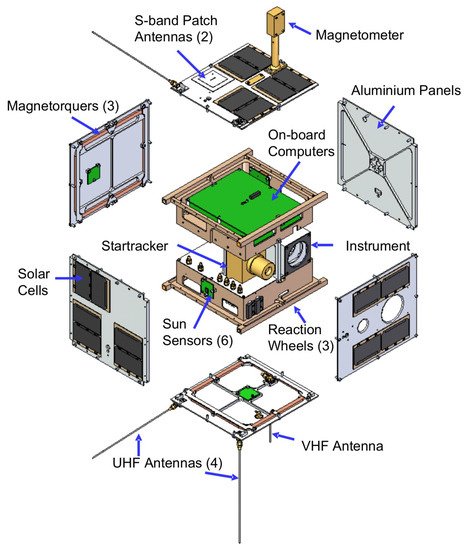
Figure 1. Basic structure of the BRITE satellites. Source: SFL.
Another root of origin is with Werner Weiss (University of Vienna, UoV) who was co-I of Evris, later of CoRoT and also a member of the MOST team. The latter membership closed the loop to CanX-3. The failure of the Evris-launch contrasted dramatically with the anticipated research potential for asteroseismology, an expectation, which was later confirmed by CoRoT and MOST. Hence, the pressure to produce a space telescope optimised for bright stars grew. Luckily, the Austrian Ministry of Science and Technology established in March 2005 a program for improving the infrastructure of Austrian Universities, to which UoV submitted a proposal for UniBRITE. This was accepted in October 2005 and, one month later, UniBRITE was ordered at SFL, based on their concept of CanX-3.
A third root is with Otto Koudelka (Technical University Graz, TUG). The Austrian Space Agency (ASA) issued in 2005 a call for the 3rd Austrian Space Programme. Two nanosatellite proposals were in the queue: one of the Institute for Astrophysics (UoV), dedicated to asteroseismology (Weiss [20]), and another from the Institute of Communication Networks and Satellite Communications (TUG), for developing and building a cubesat. ASA suggested to merge these initiatives, which resulted in a proposal with Koudelka at TUG as the PI, and which was approved by ASA in 2006. This was the birth of the first satellite built in Graz (and Austria): BRITE-Austria, also called TUGSat-1. The link to MOST is highlighted in a sentence of the proposal: BRITE-Austria will extend and supplement the spectacularly successful Canadian microsatellite MOST into the domain of nanosatellites.
As the Austrian BRITE’s were accepted for funding, Slavek Rucinski felt that Poland (his country of birth) with its rapidly improving economy should join. When the Canadian part of the project appeared to be in limbo due to CSA dragging its heels regarding funding (from 2006 until 2011), he started pushing his colleagues and former students in Poland to follow the Austrian example. Aleksander Schwarzenberg-Czerny (Copernicus Astronomical Center, Warsaw, CAMK and former PhD student of Rucinski) was able to obtain funding for two BRITE satellites at the end of 2009 and, hence, he provides the fourth root of BRITE-Constellation.
The pressure on the Canadian Space Agency (CSA) increased considerably, after Austria funded UniBRITE and BRITE-Austria, and after Poland funded BRITE-Heweliusz and BRITE-Lem. Finally, CSA accepted in 2011 the two Canadian BRITE’s (former CanX-3): BRITE-Toronto and BRITE-Montreal.
In this way, BRITE-Constellation was born with six satellites.
The goal of BRITE-Constellation [21] was to provide high-precision photometric monitoring of very bright (≲4 mag) stars in two optical wavelength bands (colours), that is, blue and red, and for up to six months, the maximum feasible time in an affordable low-Earth orbit. Various concepts have been discussed and finally a single telescope, optimized for a given passband was chosen with no moving elements on board, thus reducing risk, but which required one spacecraft per filter.
The proceedings of the First BRITE Workshop [22] provide an overview to the technical and scientific issues, which were discussed and decided before launch in 2013. The situation of the six (five active) components of BRITE-Constellation after launch (Table 1) are described in Weiss et al. [23], Deschamps et al. [24], Koudelka et al. [25] and various aspects of BRITE-data reduction in Pablo [26], Popowicz et al. [27], Popowicz [28].
Table 1. Launch and orbital information for the BRITE nanosats. BRITE-Montréal did not separate from the launch vehicle and is not operational. The red filter covers 550–700 nm, and the blue filter 400–450 nm.
| Owner | Name | Filter | ID | Launch Date | Orbit (km) | Period (min) |
|---|---|---|---|---|---|---|
| Austria | UniBRITE | red | UBr | 25 Feb. 2013 | 781×766 | 100.37 |
| BRITE-Austria | blue | BAb | 25 Feb. 2013 | 781×766 | 100.36 | |
| Poland | BRITE-Heweliusz | red | BHr | 19 Aug. 2014 | 612×640 | 97.10 |
| BRITE-Lem | blue | BLb | 21 Nov. 2013 | 600×900 | 99.57 | |
| Canada | BRITE-Toronto | red | BTr | 19 June 2014 | 629×577 | 98.24 |
| BRITE-Montréal | blue | 19 June 2014 | n/a |
Conferences were organised almost every year to discuss updates and new aspects of the mission. Most importantly, they allowed for vivid scientific discussions which helped to shape the focus of BRITE-Constellation. The first science conference took place in 2015 in Gdańsk, Poland, one year later in Innsbruck [29], and in 2017 at Lac Taureau, Canada. The conference in Vienna “Stars and their Variability, Observed from Space-Celebrating the 5th Anniversary of BRITE-Constellation” in August 2019 provided the most recent status report [30].
The BRITE instruments consist of a multi-lens telescope with an aperture of 3 cm, optimised for the red (550–700 nm) or the blue (400–450 nm) wavelength range (Figure 2, red design). The unvignetted field of view (FOV) is about 24° in diameter and the optics were chosen to provide slightly out-of-focus stellar images for improved S/N, an experience acquired from MOST. For the two Austrian, the two Canadian and the blue Polish instruments a 5-lens system was developed. The red Polish instrument (BHr) has a four-lens design, which results in a shorter telescope, but with a smaller FOV of 20°. A baffle in front of each telescope reduces off-axis stray-light from bright sources, including the Sun, Moon and Earth.
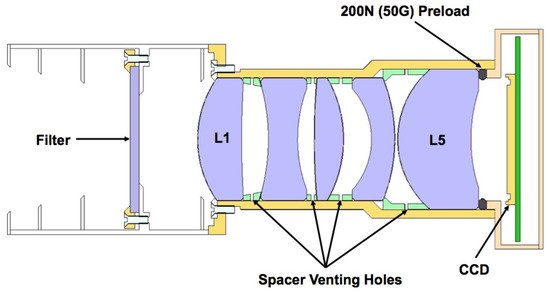
Figure 2. Camera scheme for the UniBRITE and BRITE-Toronto red instruments with a nearly vignetting free field-of-view of 24°. The red or blue filters are placed at the entrance pupil of the 5-lens camera to assure a constant filter function over the entire FOV. The blue cameras have slightly modified lens radii and separations to optimise the image quality for the needed wavelength range. Source: SFL.
The same interline frame-transfer CCDs, a Kodak KAI 11002-M (4048 × 2672 pixels and 9 μm pixel size) chip, are used for each BRITE. This is an off-the-shelf product which includes all read-out electronics and preamplifiers on a header board behind the chip. Attractive features, besides the modest price, is the low dark current at high temperatures (0°–30 °C), which allows one to avoid a cooling system, and a low read-out noise and power consumption. This CCD has been successfully used on the ground in SBIG Cameras, but never in the radiation environment of space. In order to avoid pixel saturation, the CCD is positioned out-of-focus, which, together with the optical design, results in about 8-pixel-wide on-axis stellar images. Off-center images have a more complex shape, as is shown in Figure 3. The scale is about 27″–30″ per pixel, increasing slightly towards the edge due to image distortion.
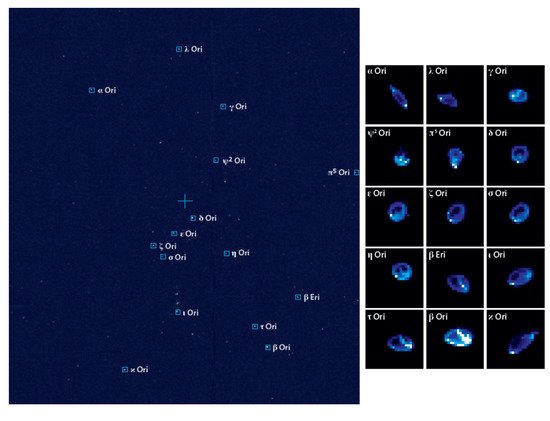
Figure 3. Full frame image of the Orion field taken with UniBRITE (UBr) in December 2013. The stars which have been selected for photometric time series are indicated. Subframes (24 × 24 pixels) which contain a full PSF, were stored in memory for a later download to the ground. Typical subframes in the center and close to the edge of the field are presented in the right panel.
The BRITE mission requirements were set in 2005 such that the instruments shall observe a selected star-field for at least 15 min per orbit. Outside that time interval, scattered light from the Earth and Sun would be encountered. Data from up to 15 stars per field shall be collected for up to 100 days. In reality the BRITE satellites typically collect data from 24 to 28 stars during 20 to 40 min per orbit over a time base of about 160 days. The exposure times typically vary between 1 and 5 s and every 21 s subframes were read out. All functioning BRITE satellites were launched into low-earth polar orbits with periods close to 100 min.
Target fields can be occulted by the Earth during part of the orbit. After the field becomes visible again and its distance from the earth-limb exceeds a critical angle, the Attitude Control System (ACS) of the satellite re-points the star field in the camera FOV. To obtain top-quality photometry, the ACS must assure stable pointing of the PSF during the entire observing run close to the same pixels (flat-field exposures are not possible), which typically is achieved within 1.5′ rms (≈3 pixels). An example of such a photometric cadence is show in Figure 4. Whenever possible, a satellite setup was chosen, allowing one to observe a second field during an orbit, when the first field was invisible for the satellite.
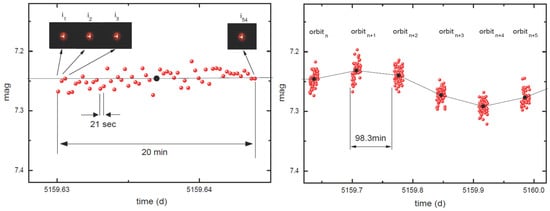
Figure 4. A typical photometric sequence of 44 Cyg (Zwintz [31]), observed by BRITE-Toronto in the field during a single orbit (left) and the data sequence during six consecutive orbits (right), indicating intrinsic light variations.
After the first BRITE satellites (UBr and BAb) were launched and the first images were recorded, features appeared which were not present in the laboratory: pixels and even entire columns with increased dark (thermal) signal, that is, “hot pixels” and “warm columns” (Figure 5). These flaws were distributed over a significant fraction of the CCD, in the FOV as well as outside with no light access. The defects became stronger during successive weeks, even at the same CCD operating temperature. The signal of “warm columns” ranged from 100 to 500 ADUs above nominal background. One ADU corresponds at 20 °C to 3.2 detected electrons. For a “hot” pixel the signal (even without illumination) is more than 100 ADUs above median background and it can even get close to saturation (≈1200 ADUs). All BRITE satellites suffer from these radiation defects, believed to arise mainly from proton collisions, which accumulate over time and adversely affect the data reduction and quality.
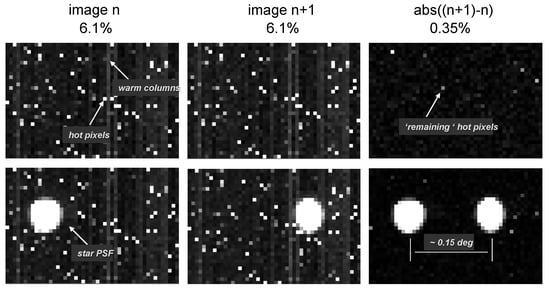
Figure 5. Illustration of the chopping procedure. Top: empty rasters (24 × 36 pixel subsets of a frame). The left and middle raster was off-set horizontally by about 0.15°. Bottom: same as for top row, but with the telescope moved to a nearby star in the raster. Right column: absolute values of the raster differences. All images here were taken at about +20 °C operating temperature. The values on top of the upper row are the % of pixels which reveal a dark current higher than 100 ADU, compared to the median background of all pixels in the respective raster.
As is described in [27][28], a very efficient technique to overcome the mentioned detector flaws and to significantly improve the accuracy of the CCD photometry is the “chopping” technique, which was introduced to the observing procedure in November 2014 and installed in February 2015 as the default observing mode for all satellites. This mode replaced the previously used “stare” mode. In the chopping mode a satellite is shifted between exposures back and forth, so that for every second raster-image the star is positioned in the other part of the raster (Figure 5). Finally, the difference of two subsequent rasters contains essentially only information relating to the stellar brightness and all local background features are close to being eliminated.
Data reduction of all BRITE photometry is the responsibility of the Data Reduction and Quality Control (DRQC) team (see Section 3.3). The data corrected for, for example, the flux values with the CCD temperature and x and y pointing positions on the CCD, are archived and forwarded to the Principal Investigators (PI) for further de-correlation. De-correlation methods have been developed by Pigulski and documented as the “BRITE Cookbook”, which can be accessed together with the software code at https://www.pta.edu.pl/pliki/proc/vol8/v8p175.pdf. Examples of BRITE photometry are presented in Figure 4, Figures 13–16, 18, 21 and 23.
Organisation and operation of BRITE-Constellation relies on six interacting teams (Figure 6), which are:

Figure 6. Organisation structure of BRITE-Constellation. BEST: BRITE Executive Science Team, MC: Mission Control, SatOp: Satellite Operation, DRQC: Data Reduction & Quality Control, BIAST: BRITE International Advisory Science Team.
BEST (BRITE Executive Science Team) is the ruling body of BRITE-Constellation. It consists of two voting members per satellite, nominated by the three member countries (Austria, Canada and Poland) which funded the BRITE satellites. BEST elects additional non-voting experts, presently 15. BEST releases 6 to 12 months before a new observing campaigns starts a BRITE Observing Plan (BOP), which typically covers 12 to 14 months of operation. The BOP defines which satellite is assigned to which field and for how long (Figure 7 and Figure 8). The rather long lead-time allows the PI’s to organise supplementary observations from the ground or from space.
MC (Mission Control) team is headed by Rainer Kuschnig (IKS, TU-Graz, formerly IfA Uni-Vienna) and is responsible for the execution of BOP by providing satellite orientation and instrument setup data. To ensure a maximum efficiency of BRITE-Constellation, a frequent quality control of all data generated with all active satellites is another core activity of MC. Such tests are applied at least twice a week and reported to BEST every second week. In case of problems, MC interacts directly with the corresponding satellite operator in charge.
A very short turn-around time between data check and satellite operation is possible, because BRITE-Constellation observes “only” up to 60 stars during a campaign and basically a single person inspects the data nearly in real time. The obvious benefit is a fast response to unexpected stellar variability. The best and most outstanding example is the serendipitous data collection from Nova Carinae 2018. Almost instantly it was apparent that BRITE-Constellation had caught the nova days before it was discovered visually. Hence, this early volatile phase could be covered by BRITE-Constellation in an unprecedented manner.
SatOp (Satellite Operation) teams are other key elements of the mission. Satellite operators are in charge of controlling the national spacecraft via the ground stations, of which one is in Austria at TU-Graz, one in Canada at SFL-Toronto and a third one in Poland at CAMK-Warsaw. However, in case of emergency, communication is possible from each of the ground stations to any satellite to ensure uninterrupted satellite control and data management. This was, and still is, usually required during harsh weather conditions at particular ground stations or during maintenance periods.
DRQC (Data Reduction and Quality Control) is another core element of the mission. The data received from each BRITE satellite on a daily basis is delivered by SatOp to MC for a preliminary quality check. Once a campaign on a given field is finished, all raw data are ASCII formatted with a FITS-like header and made available to DRQC, which generates pipeline-reduced data files (supervised by Adam Popowicz, Silesian University of Technology, Gliwice) [27], and performs quality control (supervised by Bert Pablo, AAVSO). The original data, the raw science data (ASCII) files and the time series datasets are then submitted to the BRITE Data Archive (maintained by Andrzej Pigulski, University of Wroclaw). Most of the archive can be accessed publicly, but some data are still protected for a limited time for the corresponding PIs. The BRITE Public Data Archive can be found at https://brite.camk.edu.pl/pub/index.html.
BIAST (BRITE International Advisory Science Team) is an informal group of presently 60 scientists, who have already successfully proposed relevant observations and/or are planning this in the future. Hence, BIAST members have expertise in BRITE data, have published the results and can advise BEST in optimising the observing program.
GBOT (Ground-Based Observing Team), which is headed by Konstanze Zwintz (U. Innsbruck), provides a platform for BRITE scientists and observers worldwide to support collaboration and to maximize the scientific output of BRITE-Constellation.
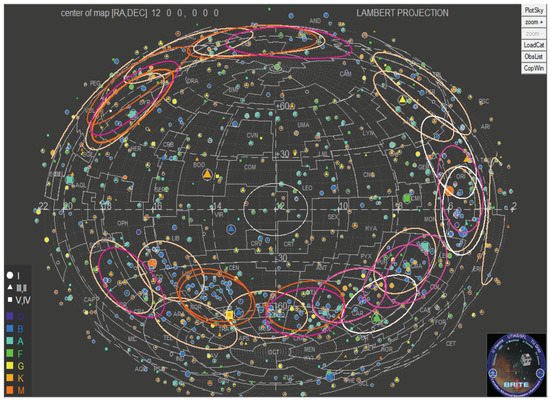
Figure 7. Sky map highlighting the fields observed thus far by at least one BRITE satellite.

Figure 8. Temporal distribution of the observations of all five active BRITE satellites until the end of 2020. The data obtained in the stare and chopping observing modes are shown with unfilled and filled bars, respectively.
The various star fields observed with various BRITE satellites since launch and until 2020 are presented in Figure 7. Which satellite observed a field in which period, either in chopping or stare mode, is indicated in Figure 8.
As of March 2021, 705 individual stars have been observed so far, often contemporaneously in two colours, and almost 6 million image-rasters of target stars have been produced. Most observations occurred in fields close to the Galactic plane, where the density of very bright stars in the FOV is high, allowing a proper choice of guide stars by the much less sensitive guiding telescope (Figure 7). Also many of the primary targets listed in the early BRITE proposals were located in this area, for example, the bright OB, B and Be stars in Orion, Carina, Centaurus or Sagittarius.
The observing strategy of BEST during the past eight years focused not only on stars of primary interest to the BRITE-community, like 6-month campaigns on hot, massive and intrinsically bright stars, but also to re-observe high profile targets essentially every possible season. The best examples are the brightest stars in the Orion field, which have been selected for the first campaign starting in December 2013 and which are currently being observed for the eighth time (Figure 8). These datasets are certainly jewels of the BRITE-Constellation legacy program.
Even though the early BRITE science program focused on O to B (including Be) type stars, it also includes now objects beyond this range in the HR diagram (Figure 12), which is indebted to wide field photometry, reaching by default many stars and of different type. For example, cool red-giants have been observed, although not originally considered a priority, but the first data analysis led already to a relevant publication. An excellent example is β Pictoris. Finally it should be mentioned that TESS obtained data for stars which BRITE satellites observed simultaneously. An example was already given in Section 1 with ζ Puppis.
For all BRITE satellites the nominal lifetime was two years. Hence, the still active satellites exceed this limit more than three times, which illustrates the high engineering quality. Nevertheless, BRITE-Constellation encountered technical problems described in the following.
The photometric accuracy is limited primarily due to stabilisation problems of BRITE satellites, but also by problems related to increasing CCD defects (Popowicz [32], Popowicz and Farah [33]). The development, e.g., of the normalised detector dark current with time is presented in Figure 9. Obviously, satellites with either a tungsten or a light weight borotron shield suffer significantly lower thermal noise increase compared to unshielded CCDs. Moreover, the sensors probably received different radiation doses during launch, as is indicated in Figure 9 by the onset of the linear approximations.

Figure 9. Temporal development of the CCD dark currents.
The status of individual BRITE satellites can be summarized as:
In conclusion, presently three of the five functioning BRITE-Constellation satellites are still operational: BHr and BTr are producing very good data and BAb still useful photometry. BEST expects to continue the mission until at least in 2022, depending on unpredictable technical failures, for example, of the reaction wheels. Attempts to recover the other two BRITEs will continue.